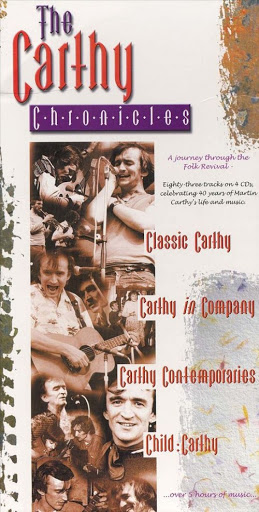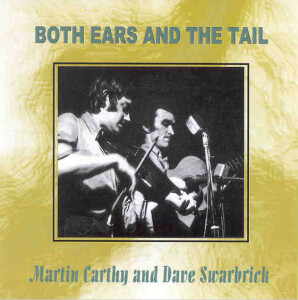 “He’s a storyteller — he knows how to put a story across and he believes 100% in what he does.” Norma Waterson
“He’s a storyteller — he knows how to put a story across and he believes 100% in what he does.” Norma Waterson
Martin Carthy is a legend in English folk music. As a solo performer, in duets with Swarbrick and others, as part of various groups, or as a session player he has left an indelible mark on the history of his nation’s music. Last year the Queen recognized him for his services to the culture of the nation by placing him on her birthday list. The elfin guitar player I met in Brantford Ontario (after a gig with Waterson:Carthy) gave no impression that this recognition had gone to his head. He engaged me in a conversation about Bahamian guitarist Joseph Spence, and happily signed autographs for his fans. How do you celebrate a career that has lasted for 40 years? Free Reed Music, has compiled a collection of his recordings that is at once representative and in depth, and at the same time makes the listener yearn to hear more.
The Carthy Chronicles is a four disc retrospective that arrives in a long box, with packaging that is supposed to include two posters, a 100-page book and four jewel boxes. The first 5,000 copies also include a mail away offer of a biographical CD-rom. (Review copies came too early for the posters to be included, but they provided an email address and a promise to mail them when they become available.) It is perhaps the heaviest box set in my collection, and part of that weight is the sheer volume of music presented.
Rather than present the tunes chronologically, Free Reed has taken an admirable approach. They have divided the career of Martin Carthy into four sections and provided a single disc each. Disc One is called Classic Carthy, and it serves as both an introduction to his career and a survey of his greatest hits. The set kicks off with “Scarborough Fair,” the song Martin famously taught to Paul Simon, only to have Simon & Garfunkel enjoy the hit. Free Reed doesn’t take the easy route, though; they have used not the original Carthy recording but a much later version (1998) recorded with Wood, Wilson & Carthy in an unfamiliar arrangement. Steeleye Span, the Watersons, Richard Thompson, and Brass Monkey are also included on the first disc, displaying a breadth of interest far beyond that usually shown by an acoustic guitarist.
Carthy’s guitar playing is a rare treat. In concert you find yourself entranced by the seeming simplicity of his chording and picking, and yet amazed by the complexities of rhythm and sound coming from his old Martin guitar. In a 1975 interview in Sing Out Martin Carthy described his guitar style:
“A lot of tricks we (himself and Nic Jones) use on guitar are fiddlers’ tricks. He (Jones) actually plays the fiddle, very well, too. So a lot of it comes from listening to people who play the pipes and people who play the melodeon … (his thumb) crosses … it’s part rhythm, isn’t it?… It’s basically a claw hammer thing, really. You’d call it Travis picking, I suppose, but I use three fingers and the thumb … it’s basically that, only cutting one of the beats out, so that you use the thumb as well to play a melody note. Instead of going ‘dong, ding, dong, ding, dong’ you go ‘dom … dom … dom … dom,’ and the second beat is used to play a note of the melody. On certain things I rest the heel of my hand on the guitar. If you whack the bottom string with the heel of your hand on it, you get this ‘thunk’ and it carries over onto the fifth string, which then drones. You’re not actually striking the second string, you’re just sounding it as you’re going past … I tend to play either what I’m singing or a very, very basic variation on that, or just the skeleton of what I’m singing …”
Well, small wonder I’ve been having trouble trying to describe his guitar playing! Suffice it to say that it is some of the subtlest virtuoso guitar I’ve ever heard. While people like Bert Jansch and John Renbourn leave you gasping for breath at their technique, Carthy leaves you in quiet awe.
The second disc is entitled Carthy in Company and provides a cross section of his work with the Albion Band, Steeleye Span, Band of Hope and others. It is on this disc that the earliest Carthy recording appears, the 1963 Thamesiders with Davy Graham version of “Wimoweh” from a Decca EP. Waterson:Carthy (the group which includes his wife Norma Waterson and their daughter Eliza) is also represented on this disc, by the closing track to their most recent album. The songs on these first two discs are a virtual history of the British folk tradition. They range from Geordie songs like “Byker Hill” to protest songs (“Arthur McBride”), Morris tunes like “The Royal Forester” to skiffle tunes from the blues tradition “My Girl.” Listen to Martin’s electric guitar playing the organ sound on Steeleye Span’s “Boys of Bedlam.”
Twentieth century songwriters are featured on the third disc Carthy Contemporaries. Richard Thompson, Bob Dylan, Berthold Brecht and Carthy himself are covered here. The disc begins with a straightforward version of Gilbert O’Sullivan’s “Nothing Rhymed” which shocked many of Carthy’s fans when he included it on a 1979 album, but Martin makes it work and it ushers O’Sullivan into the pantheon of fine songwriters. Dylan is represented by Carthy’s take on “The Lonesome Death of Hattie Carroll” which tells the true story of a bizarre manslaughter case. For the past few years Richard Thompson has been featuring a humorous retelling of Shakespeare’s Hamlet (“Hamlet” by Frank Loesser) in his live shows, but Martin Carthy has uncovered a different, even funnier song called “Oor Hamlet” which Glasgow songwriter Adam McNaughton wrote to teach the play to school children.
This disc concludes with a track from Carthy’s next CD. Later this year Topic will release Martin’s first all instrumental album and judging by “The Third Man Theme,” which appears here, it will be a corker!
The Carthy Chronicles concludes with a disc called Child: Carthy on which “20 rare, unreleased & classic ‘Child’ ballads” are featured. Between 1883 and 1898, Francis James Child, Professor of English at Harvard University, published his massive collection of English and Scottish popular ballads. His work, although it mirrored the efforts of other scholars, was so definitive that his name became attached to the songs as a kind of definition. Martin Carthy says, “I think my job is to try and make other people understand how extraordinarily beautiful the music is. I try and make them understand that this was just written by people like them. It’s ordinary people’s music — it’s ordinary people’s poetry.” On this disc the listener becomes aware of just what a good singer Carthy is. His voice is clear and true, and his sincerity about telling these tales, sharing the lives of these centuries old travellers becomes apparent. The collection ends with a ’93 recording of Carthy and Bert Jansch doing “The Elfin Knight” (the source ballad for “Scarborough Fair”), and so the circle continues.
The Carthy Chronicles is a massive set. Sure there are lots of four disc box sets on the market, but this one includes more rare and unreleased tracks than almost any one I’ve ever seen. It leaves the listener hungry for more! I can’t wait til the instrumental disc is released later this year! Free Reed have truly chronicled the life and career of one of Britain’s most important talents and are to be commended for doing so with such grace and panache!
(Free Reed Music, 2001)
 If four discs is too much for you, if you would like to try some Martin Carthy by dipping your toe rather than diving in, a new release from Gadfly Records may be just what you need. Both Ears and The Tail is a recording of Carthy with Dave Swarbrick live at the Folkus Folk Club in 1966. It provides the whole show minus some tuning, with Carthy on guitar and vocals, and Dave Swarbrick playing fiddle and mandolin. They play reels and Morris tunes, rags and Child ballads, for an enthusiastic college crowd. Dave and Martin are consummate performers, humorous raconteurs, and virtuosic musicians. The recording is extraordinary for being 35 years old and it is a great introduction to the music of Martin Carthy.
If four discs is too much for you, if you would like to try some Martin Carthy by dipping your toe rather than diving in, a new release from Gadfly Records may be just what you need. Both Ears and The Tail is a recording of Carthy with Dave Swarbrick live at the Folkus Folk Club in 1966. It provides the whole show minus some tuning, with Carthy on guitar and vocals, and Dave Swarbrick playing fiddle and mandolin. They play reels and Morris tunes, rags and Child ballads, for an enthusiastic college crowd. Dave and Martin are consummate performers, humorous raconteurs, and virtuosic musicians. The recording is extraordinary for being 35 years old and it is a great introduction to the music of Martin Carthy.
(Gadfly Records, 2001)
